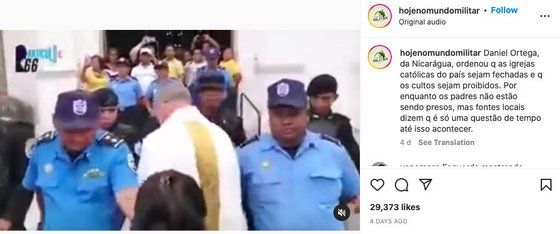A tight line of police officers outside a church. A crowd waiting outside and a priest trying to get in. Unsuccessfully. The agents hardly move, but they make it clear that they don’t want to let him pass. The priest ends up speaking to the media that are also present: “We do not have the right to celebrate worship in Nicaragua. We have no right to celebrate the Eucharist,” he says.
The video showing this situation was shared on a Brazilian Instagram account on August 18. The caption describes the situation as follows: “Daniel Ortega, from Nicaragua, ordered the closure of the country’s Catholic churches and the prohibition of services. At the moment, the priests are not being arrested, but local sources say it is only a matter of time before that happens.”
The statement is that the president of Nicaragua – who after 11 years in power in the 1980s returned in 2006 and has remained in office ever since – will be closing all Catholic churches in the country and prohibiting the celebration of masses. The video, in theory, illustrates one of the moments in which one of the country’s churches was closed. But will it really be so?
The origin of the video in which the faithful are prohibited from entering a church
Let’s start by looking for the source of the video in question. In the image you can see that it has the watermark of Article 66, an independent media outlet in the country founded by the journalist Álvaro Navarro, who has reported on the difficulties in exercising the profession under the leadership of Ortega.
However, a finer investigation allows us to discover that the original video dates from 2019. Parts of the video are available in a publication made by the Reuters agency and replicated by the Spanish newspaper El País.
The newspaper explains, in a news item from November 2019, the context in which these images were captured. Everything takes place in the parish of San Miguel Arcángel, in the city of Masaya, directed at the time by Father Edwing Román. That November, the priest decided to help 14 people who were on a hunger strike, demanding the release of their relatives – serving a sentence for having participated in the demonstrations against the Sandinista regime the previous year, in which more than 300 people died, mainly due to police repression.
In reaction, Nicaraguan police surrounded the church and cut off electricity and water to the building. Father Román remained inside the building together with the relatives of the prisoners for several days, as he himself confirmed in photographs that he posted on his Twitter account.
Sunday mass was celebrated behind closed doors in the Chapel of the Blessed Sacrament of my Parish; with the mothers of the PP praying for the freedom of all of them, surrounded by police, riot police and paramilitaries besieging us.#SOSNicaragua pic.twitter.com/zM5Xac3emz
– Edwing Roman (@EdwingRoman14) November 17, 2019
The parish priest also verified that the police prevented access to the church to the faithful.
A woman carrying her son, if she joins the “police” of Nicaragua, so that she can enter the Parish of San Miguel Arcángel de Masaya, on November 14, 2019, to visit and pray to the Blessed Sacrament, and it is not allowed The Nicaraguan police harass us. https://t.co/8uBFIigUgH pic.twitter.com/8HMgLJkYrF
– Edwing Roman (@EdwingRoman14) November 3, 2020
The video proves, however, that the images in question are more than two years old. It should also be noted that the video could not have been captured in recent days, since Father Román has been in exile since January of this year. Sick in health, he left the parish and is currently in Miami (USA), as confirmed at the time by the Archbishop of Managua.
The tension between the Ortega regime and the Church since 2018
It is true then that the video is true, but that it is not about the closure of Catholic churches throughout Nicaragua, which by the way was not decreed by President Ortega. Does this mean that the claim is entirely made up?
Not quite. Although Catholic churches remain officially open for the time being, freedom of worship in the country has been limited since the 2018 protests broke out and several Catholic Church officials in the country supported the protesters. Since then, the Ortega regime has accused several bishops and priests of aiding alleged coup attempts.
This summer the tension between Ortega and the Church has increased. In July, the government closed the Missionaries of Charity association and expelled 18 nuns from the congregation from the country. In early August he ordered the closure of six Catholic stations, as confirmed by the Spanish news agency EFE.
Since then, various religious acts have taken place under police surveillance. Earlier this month, the government prohibited the holding of a procession and placed an ostentatious police device at the mass that was celebrated that day in the Managua Cathedral.
On the 19th of this month the tension rose in tone. Several police officers entered the Episcopal Palace of the Diocese of Matagalpa and arrested Bishop Rolando Álvarez and seven other people. Álvarez, a well-known critic of Ortega, is now formally accused of “organizing violent groups” with the purpose of “attacking the constitutional authorities” and remains under house arrest.
The situation is so serious that it has already provoked the reaction of the Secretary General of the United Nations, António Guterres, who says he is “very concerned” about the attitudes of the State of Nicaragua towards civil society organizations such as the Catholic. Church and highlighted the Álvarez case. Pope Francis also said that he felt “concern and sadness” about the situation in the country.
Conclusion:
It is true that the Daniel Ortega regime has been waging a tug-of-war with the Catholic Church in Nicaragua since 2018, which seems to have escalated in the last two months, and that freedom of worship has been limited at times. However, the closure of all churches was not decreed, nor was the exercise of religious freedom formally prohibited.
The video used, although it is a police action against a church that was closed to the public, dates from 2019.
Thus, according to the Observer classification, this content is:
DECEIVER
In the Facebook rating system, this content is:
PARTIALLY FALSE: Content claims are a mixture of accurate and inaccurate facts or the main claim is misleading or incomplete.
NOTE: This content was curated by The Observer as part of a fact-checking partnership with Facebook.

Source: Observadora
